Last Updated on January 18, 2024 by Greg Gillson
Many people find joy in feeding birds during the winter. This article is for those who may want to start feeding birds for the first time. But even if you’ve fed birds before, you may find some new tips here for feeding birds in Illinois in winter.
This article tells why and how to set up a winter bird feeding station in Illinois. I’ll also include photos and brief identification of some of the common feeder birds you should expect, and how to best attract them.
Winters in Illinois are cold, often bitterly so. Illinois gets 14 to 38 inches of snow each winter, plus rain (source).
Surprisingly, many birds remain in Illinois in the winter. Many will appreciate any snacks that you can provide at your backyard bird feeder. At times, your feeding wild birds can mean the difference between life and death!
Why feed winter birds in Illinois?
Ice and snow storms can make it hard for birds to find food in winter. Birds have high metabolisms. They need to eat to keep up their body temperature and activity levels. Thus, your reliable winter bird feeder is just what they need!
Near the larger cities there is what is called a heat island. Temperatures are a few degrees higher than in surrounding areas, aiding birds. So there may be more birds in town than in the countryside in winter. But they may still need an added source of food.
Birds also need a source of drinking water every day–even in the winter. Can you provide open water for birds when all other sources are frozen? That will certainly help the birds.
Keep in mind all the young birds hatched the previous spring. They have never gone through an Illinois winter before! They are inexperienced at finding winter food. Your bird feeding station is a welcome treasure of winter food.
Watching birds on those dreary winter days brings many people hours of enjoyment. Nature is good for mental health. Even nature out the window in the form of birds at your feeder is beneficial.
Caring for a bird feeder may teach young people about responsibility. A bird feeder could help teach math and science and writing for home schoolers. Identification, behavior, migration, the inter-connectedness of life are things that all people can learn from a bird feeder, regardless of age.
Keeping up a bird feeder may also provide older individuals with a daily purpose. The routine of filling the feeder and having ones to care about are important. It really doesn’t matter our age. This activity is good for us.
What birds come to feeders in Illinois in winter?
There are several species of birds that are regular at bird feeders in winter. Many of the most likely in Illinois are presented below.
There are also other birds that may be found in your backyard that don’t come to your feeder. But they are easy for you to spot, nonetheless. You may learn about them in a related article I wrote: Common backyard birds in Illinois. I’ll provide this link again at the end of this article.
The summaries here below present basic identification. They also tell you what food you can put in your bird feeder to attract them. If the birds have a preference, I also tell what kind of bird feeder they like to eat from.
Dark-eyed Junco
You may note small flocks of these tiny sparrows feeding on the ground under your feeders.
 |
| Dark-eyed Junco Photo by Greg Gillson |
They nest in the forests of Canada and Alaska and mountains in the West and East. They move south into most of the United States in winter. They are found throughout Illinois in winter.
Pudgy with a big head. The tail flashes white outer tail feathers. They are gray above, including a full hood, with a white belly. Legs and small conical bill are pink.
They give twittering calls and smacking notes. In spring they sing a long musical trill on one pitch.
Dark-eyed Juncos eat small seeds. These are one of the few birds for which the cheap mixed bird seed is the best. They want to eat from the ground, so a low platform feeder is best. They will also eat from a hopper feeder.
Northern Cardinal
 |
| Northern Cardinal Image by tlparadis from Pixabay |
These colorful backyard birds are resident in woodlands in the eastern and central United States south into Mexico. They are found throughout Illinois year-round.
Both sexes are told by their conspicuous crest, large conical bill, and ample rounded tail. Males are bright red, females dull brown, both with black feathers on the face and throat.
Both sexes sing throughout the year. The song is a loud whistle “birdy birdy birdy” or “cheer cheer cheer.” The call note is a sharp chip.
Northern Cardinals eat large seeds such as sunflower seeds and safflower seeds. They prefer a large platform feeder, but will eat at hopper feeders, too.
Downy Woodpecker
These are very small woodpeckers.
 |
| Downy Woodpecker Photo by Greg Gillson |
They are found year-round in deciduous woods, even willow wetlands. Their range extends from Alaska, across Canada and throughout most of the United States except for the deserts in the West and Southwest. They are found throughout Illinois.
They are stout, with a short, stiff tail. The bill is chisel-shaped but very small. Both sexes have white backs, black shoulders and wings with white spots on the wing. The under parts are white. There are white outer tail feathers on the black tail. The head is striped black-and-white. Males have a small red spot on the nape.
They give a sharp “pik” call and rattling whinny as a spring song.
Downy Woodpeckers may roam with chickadees and nuthatches in a mixed winter flock. They usually only come to your feeder, though, if you offer suet.
American Tree Sparrow
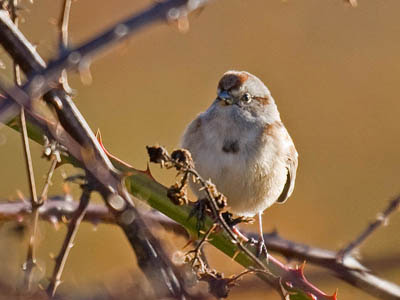 |
| American Tree Sparrow Photo by Greg Gillson |
These small sparrows breed in willows and spruce at edge of tundra across Alaska and northern Canada. They winter in the northern United States east of the Rockies. They winter throughout Illinois.
Their winter habitat is weedy fields where they are usually found in active moving flocks. They are common visitors to backyard feeders, too.
Petite and gray with brown back striped with darker brown lines. The head is gray with rufous crown and mark back from the eye. There is a dark spot in the middle of the pale gray breast.
Call notes include a musical “teedle.”
American Tree Sparrows eat small seeds. They will like the mixed seed blends on a platform or hopper feeder.
Blue Jay
 |
| Blue Jay Image by skeeze from Pixabay |
These noisy and brash birds breed across southern Canada and most of the United States, west of the Rocky Mountains. They favor oak groves. Also found in deciduous woods and trees in towns. They withdraw from the northernmost parts of their range in winter. They are found throughout the year in Illinois, however.
Blue above with a crest. White below. They have a black necklace that wraps around the head, bordering a white face. Wings and tail are blue, barred with black and white. Large white wing patches and tail corners.
Voice is varied, but includes jay jay jay calls.
Blue Jays eat larger seeds and nuts, including peanuts. But they may carry off sunflower seeds in large gulps to cache–bury for eating later in the winter. They are also aggressive toward other birds, so they are not always welcome by those who feed birds. They will eat from hopper feeders and also platform feeders.
House Finch
These small birds are generally found in small flocks at the tips of trees or telephone wires in towns.
 |
| House Finch Photo by Greg Gillson |
Resident across most of the United States, Mexico, and extreme southern Canada. They are found throughout Illinois.
Birds are dusty brown above with darker streaks. Lower underparts have wide dark streaks on whitish background to belly and flanks. Males are orange-red on the forehead, throat and upper breast, and rump. The bill is conical, but slightly rounded on the culmen (upper ridge). The tail is square-ended or only slightly notched.
Calls are a chirping wheep. Loud wiry song is given throughout the year includes musical phrases usually ending in a nasal weeer.
House Finches love black oil sunflower seeds and feed best from tube feeders. Attracted to bird baths.
Red-bellied Woodpecker
A fairly good-sized woodpecker found in woodlands and towns.
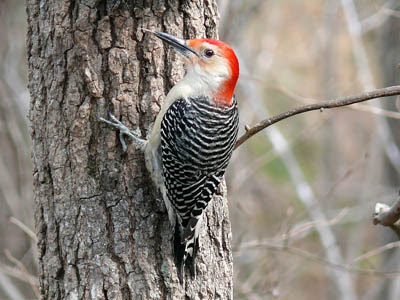 |
| Red-bellied Woodpecker Image by skeeze from Pixabay |
They are found in the eastern United States. They live year-round throughout Illinois.
Note the long chisel-shaped bill and short tail. Birds are pale below and on the head. The back and wings are barred with fine black and white lines. Birds have red hind crowns that extend to the bill on males. Often seen hitching up trees using their tails as a prop.
Calls are a loud rolling churr.
Red-bellied Woodpeckers come to backyard feeders for suet and peanuts.
American Goldfinch
You may be familiar with these tiny bright yellow birds in summer. They are still around in weedy fields and backyards in winter, too. They are just hiding in a dull winter plumage.
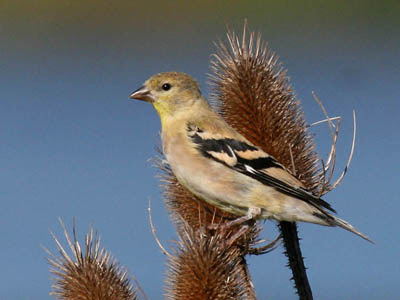 |
| American Goldfinch Photo by Greg Gillson |
In summer these birds nest in southern Canada and across the northern and middle United States. In winter birds move out of Canada for the most part and can be found all through the U.S. They are found year-round in Illinois.
In winter these birds are rather dull brown with yellowish throats. The dark wings and tail have broad pale or white bars and edges. The bills are conical, but small. The tail is short and deeply forked.
In flight they call a lilting per-chick-o-ree.
American Goldfinches love black oil sunflower seeds from tube feeders. They also love Niger seed from special thistle socks or “finch feeders.”
White-breasted Nuthatch
These active little birds, along with chickadees, often make up the core of roaming mixed flocks of several woodland species.
 |
| White-breasted Nuthatch Image by GeorgiaLens from Pixabay |
These birds live in deciduous woods in the East and oak and pine woods in the West. Their range is complicated. They are absent in deserts and the Great Plains where trees are scarce, but also are mostly absent from Texas to Florida. They are, however, found throughout Illinois year-round.
Small and pudgy, they have a big head with long thin chisel bill and very short stubby tail covered by the wing tips. These birds are blue above and white below. The face is white. The males have a black crown. Females are generally similar but duller.
Calls are varied by population. Nasal yank calls are common.
White-breasted Nuthatches come to tube or hopper feeders to grab a black oil sunflower seed. They fly away with it and pound it open on a branch. Then the return to the feeder for another seed–one at a time.
Mourning Dove
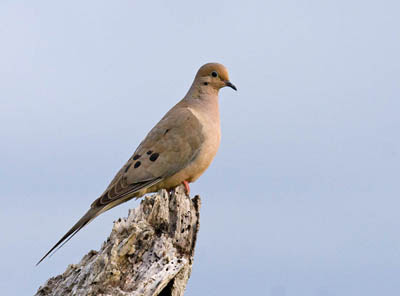 |
| Mourning Dove Photo by Greg Gillson |
These somewhat large backyard birds are widespread across southern Canada and across the United States in summer. They move out of Canada and the northernmost states in winter. However they are residents throughout the year in Illinois.
They are plump and brown, with a pink cast on the breast. There are large black spots on the wing coverts. The head is small and round on a longer neck. The tail is long and pointed, with white edges.
Their song is a sad cooing.
Mourning Doves feed corn, sunflower seeds, and grains. They like to feed on the ground and platform feeders.
Black-capped Chickadee
These tiny little birds are a winter-time joy.
 |
| Black-capped Chickadee Photo by Greg Gillson |
They are found in Alaska and across Canada and the northern United States. They are found year-round in northern Illinois.
Pudgy with hardly any neck, they show a large head with a short stout bill. They are gray on the back, wings, and tail. Under parts are pale, buff on the flanks. They have a white face with black cap above and big black throat patch.
Calls are a measured chick-a-dee-dee-dee. Spring songs are whistled fee bee bee bee, with regional variation.
Black-capped Chickadees love black oil sunflower seeds taken one at a time from a tube or hopper feeder.
Setting up a winter bird feeding station in Illinois
I recommend setting up a tube feeder and a hopper feeder in winter in Illinois.
Put black oil sunflower seeds into a tube feeder. This will attract House Finches and American Goldfinches. White-breasted Nuthatches and Black-capped Chickadees will also eat seeds from this feeder.
A hopper feeder with mixed seed containing more white proso millet and less milo will appeal to a wide variety of backyard birds.
Milo is not liked by many birds and may be up to half the volume of cheap bird seed mixes. If milo is one of the first 3 ingredients listed, don’t buy it! Milo also attracts House Sparrows, which many people don’t want because of their messy and aggressive behavior.
So, more millet and maybe some sunflower chips. This won’t be the least expensive mixed seeds, but is well worth it. Dark-eyed Juncos, American Tree Sparrows, Northern Cardinals, and Mourning Doves will like this feeder better, but other birds will eat from it, too. Because of the snow, I suggest a feeder with a big overhanging roof.
If you add a suet feeder you will soon attract both Downy and Red-bellied Woodpeckers! Other birds such as wrens, nuthatches, chickadees, and others will also eat suet.
Many people don’t consider a bird bath in winter. But birds need to drink water daily. A winter feeding station in Illinois really needs a bird bath or other source of liquid water.
Please consider adding some kind of bird bath heater. During freezing spells, birds can have a hard time finding water. And birds that don’t come to feeders may come to your bird bath for a drink.
There are so many backyard winter birds in Illinois that you should have several different feeders and offer a variety of foods.
Wrapping Up
Birds have a surprisingly diverse toolkit for coping with the harshest winter conditions. They employ a combination ofadjustments to survive the coldest months. These include:
- Feathers: These fluffy marvels act as an insulating layer, trapping air close to the bird’s body and preventing heat loss. Some species even grow an extra layer of downy feathers in winter for added warmth.
- Counter-current heat exchange: This ingenious trick minimizes heat loss in extremities like feet and legs. Arteries carrying warm blood from the core flow alongside veins returning cold blood, warming the cold blood before it reaches the body and preventing precious heat from escaping.
- High metabolic rate: Birds have remarkably fast metabolisms, allowing them to burn food efficiently and generate internal heat. Shivering also plays a role, though it’s typically less effective than in mammals.
- Smaller size: Smaller birds have a higher surface-to-volume ratio, which unfortunately makes them lose heat faster. However, this disadvantage is countered by their ability to quickly find food and shelter due to their agility.
Frequently Asked Questions
Where do Illinois birds go in the winter?
Illinois birds take different paths in the winter, depending on the species and its individual preferences. Here’s a breakdown of their potential destinations:
Staying in Illinois:
- Resident birds: Some species, like cardinals, blue jays, and chickadees, are well-adapted to Illinois winters and remain year-round. They find enough food and shelter in the state’s diverse habitats, including woodlands, prairies, and urban areas.
- Short-distance migrants: Certain birds like robins and goldfinches venture south within Illinois or to neighboring states like Missouri and Kentucky. This allows them to escape the harshest conditions while staying close to familiar territory.
Traveling further south:
- Long-distance migrants: Many warblers, thrushes, and shorebirds embark on epic journeys, flying thousands of miles to Central or South America. These species require warmer climates and abundant food sources unavailable in winter Illinois.
- Waterfowl: Ducks, geese, and swans often head south, following open water sources like rivers and lakes. Some prefer the Gulf Coast, while others venture as far as Mexico or South America.
Do finches stay in Illinois for the winter?
Whether finches stay in Illinois for the winter depends on the specific species, with some residing year-round while others embark on migration journeys. Here’s a breakdown:
Finches that stay in Illinois:
- House Finch: These common residents readily adapt to winter conditions, relying on seeds and other plant material available throughout the year.
- American Goldfinch: While their plumage dulls in winter, these finches often stay put, feasting on thistle and other seeds.
- Purple Finch: These adaptable finches may stay or move depending on food availability and weather conditions. They are particularly attracted to sunflowers in winter feeders.
- Pine Siskin: These irruptive migrants may appear in Illinois winters in response to abundant conifer seed crops.
Finches that migrate from Illinois:
- Common Yellowthroat: These bright warblers head south to Central America and northern South America for warmer climates and insects unavailable in winter Illinois.
- Indigo Bunting: These vibrantly colored birds migrate to southern Mexico and Central America, returning in spring.
- Yellow-breasted Chat: Like other warblers, these chats undertake long journeys south to escape the harsh winter and find plentiful insect prey.
- Eastern Phoebe: While some pheobes might linger in sheltered southern Illinois areas, most migrate to southern Central America and the Caribbean.
Related Articles:
The most common backyard birds in Illinois
Birds at your feeder in Illinois
Red, Orange & Yellow Birds at Your Feeder in Illinois
My recommended bird feeder setup
Bird seeds that attract the most birds
Different kinds of bird feeders for different birds






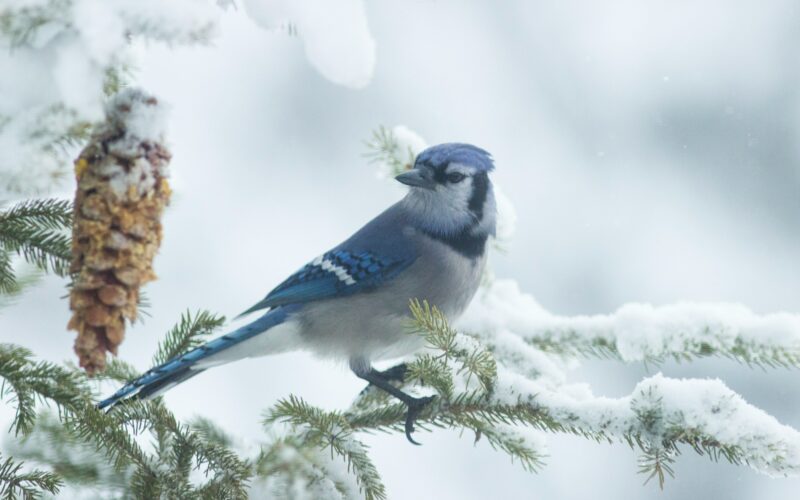

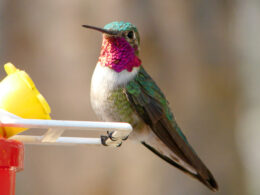
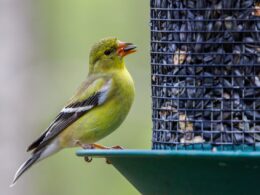
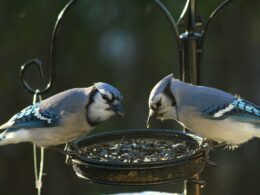
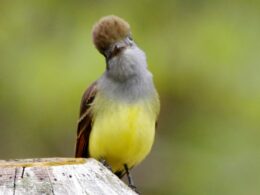
Thank you for this info!! I love birds but only recently moved to the suburbs where I can feed them so I'll take your advice when going shopping for bird food. Thank you!
You are welcome. Enjoy the birds at your new home!
It helped to know what birds were feeding in my back yard and what I should feed them. Thank you.
So glad I could help!